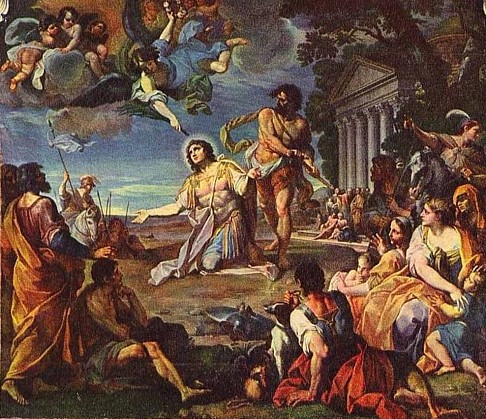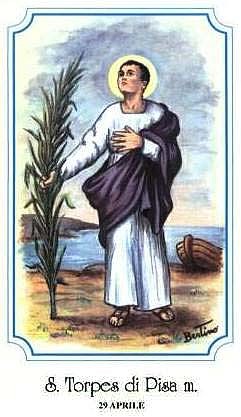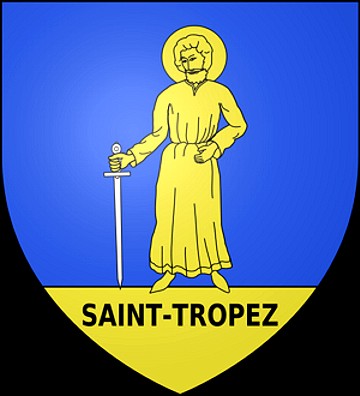|
|
Francia
Saint-Tropez
dipartimento Var
|
|
San Torpete

Martirio
di San Torpè - Olio su tela - Duomo di Pisa
A Pisa in via Fedeli è presente la Chiesa e il convento di San Torpé
Caius
Silvius Torpetius (morto a Pisa il 29 aprile 65 o 68), conosciuto anche come
Torpè, Torpes, Torpete, Torpezio, Tropezio, Tropez, è venerato come santo
dalla Chiesa cattolica. Proveniente dalla città di Pisa, fu cortigiano di
Nerone![]() .
.
San Torpè visse al tempo in cui Pietro apostolo, prima di raggiungere Roma, si fermò presso la Basilica di San Piero a Grado. Torpè venne perseguitato in quanto cristiano e costretto, senza successo, a praticare la religione pagana adottata dall'Impero Romano. L'imperatore Nerone, il quale credeva nella dea Diana come progenitrice dell'Universo, lo fece torturare e decapitare; dopo la sua morte, il corpo fu abbandonato sopra un'imbarcazione (insieme a un gallo e un cane) alla foce dell'Arno che si arenò in una località non identificata chiamata Sino. Al santo si attribuiscono molti prodigi tra cui, nel giorno 29 aprile 1633, la liberazione dalla peste,dilagante nella città di Pisa. Oggi sono molte le nazioni che rivendicano il Santo ed esistono molte chiese dedicate al suo culto. La città di Saint-Tropez, in Costa Azzurra, prende il nome dal santo pisano.
«Hoc vobis praeceptum ut in Gradu ad mare ibidem decolletur. Et venerunt in Gradum Arnensem: exierunt ripam fluminis. S. Torpes dixit: “Dominus Deus meus, suscipe spiritum meum”. Nihil aliud dixit, nisi oculos levavit in caelum, et sic decollatus est. Ministri autem invenerunt naviculam modicam foris, quae iam nullam utilitatem facere poterat (...) et miserunt in ea corpus Iusti et canem et gallum cum eo: et tam diu ibidem steterunt, dum eam non viderent.»
(Passio Sancti Torpetis, in Acta Sanctorum, Maii, IV, Antverpiae 1688, p. 6.)


Torpes on the coat-of-arms of Saint-Tropez
Saint Torpes of Pisa (Torpetius, Tropesius) (French: Saint Torpès, Saint Tropez, Italian: Torpete, Torpes, Torpè) (d. 65 AD) is venerated as an early Christian martyr. He is the namesake of Saint-Tropez. His legend states that he was martyred during the persecutions of Nero. Most of the accounts about him are considered unreliable. Nothing else is known about his life. He is first mentioned in sources dating from the ninth century.
Elaborations of his legend state that he was a gladiator or knight who was an attendant to the Emperor Nero, or head of the emperor's personal bodyguard. His full name was Caïus Silvius Torpetius and he was a native of Pisa. Torpes became a Christian after being converted by Saint Paul. Torpes professed his faith during a ceremony in which Nero declared Diana to be the creator of the universe. After Torpes declared himself to be a Christian, Nero did not want to kill Torpes immediately and instead asked his attendant to renounce his faith. When Torpes refused to do so, Nero had him decapitated. Another variation of the legend states that Torpes left Rome and went to Pisa, but was recognized as a Christian by the local prefect, Satellicus, who had him executed.
Torpes’ head was tossed into the Arno (and was later claimed by Pisa). His body was placed in a rotten boat with a rooster and a dog, who had been placed there in order to nourish themselves on the saint's body. The boat floated towards Liguria. A holy woman named Celerina (Célèrine) had a premonition in a dream of the arrival of the saint's body, and indeed the boat reached the present-day location of Saint-Tropez, where Celerina lived. The boat landed not far from the present-day sailors' cemetery. The body was untouched by both the rooster and the dog. The cock flew away towards the village later named Cogolin after it; the dog headed towards the village later named in its honor Grimaud.
The local people named their village in honor of him. The theme of the relics being transported across the sea in a small boat is a tale found in the legends of other saints of the region, such as Saint Reparata and Saint Devota. Places on the coasts of Spain and Portugal also declared themselves to be the locations where Torpes' boat had landed. Torpes was venerated in Pisa, Genoa, and Portugal. He became the patron saint of sailors.
The earliest church in Pisa dedicated to him dates from the eleventh century. The civil code of the Republic of Pisa of 1284 established April 29 as the feast day of the saint. The Pisans credit Torpes with ending a terrible plague that afflicted the city in 1633. In Genoa, where the cult of Torpes was imported by Pisan merchants, the church of San Torpete is dedicated to the saint. In Saint-Tropez, his bust is honored during Les Bravades des Espagnols, a religious and military celebration commemorating the victory of the Tropezian militia over the Spanish in 1637.